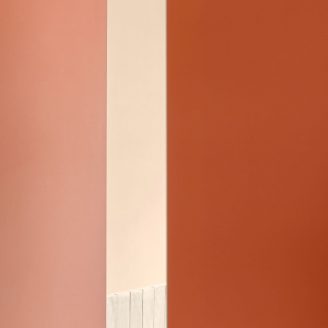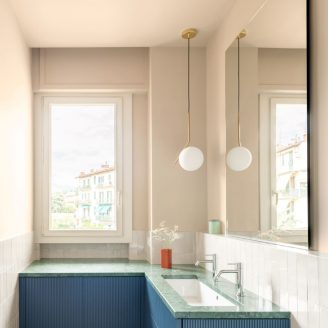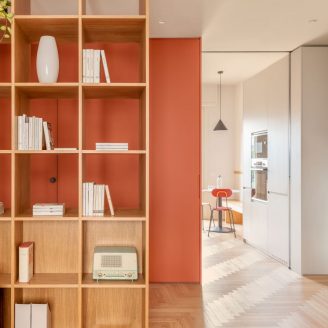In the Le Cure district of Florence, at the foot of the Fiesole hills, a young couple with a passion for architecture and fashion, chose studio DEFERRARI+MODESTI to design a bright and cosy apartment set in a late 1970s complex, which develops around a large inner courtyard
The result is House AD, where the intervention completely transforms and revises the existing building, trying to make the rooms as connected and bright as possible, taking advantage of the flat’s double exposure.
The different functions maintain their location, being interconnected by continuous furnishings, which develop on the new design of the spaces. The customised furnishings not only characterise the various rooms, but also make the most of the available space by articulating into storage units, partitions, sliding panels with different colours and textures.
The house is entered through a large entrance hall, where various volumes and furnishing devices are placed. Among these, a long cabinet with double oak shelves and an enamelled metal frame is used both as a bench and as a place to store objects and clothing. Above the bench is a large circular mirror, while a full-height lacquered oak wall unit occupies the opposite wall. It is a piece of furniture that runs along the corner between the entrance and the kitchen, placed at the transition between the two spaces. This wall unit has a dual function, at the entrance, that of wardrobe and storage for most of the utensils associated with the young couple’s passions, and in the kitchen, that of incorporating the tall units and pantry. The cabinet also contains a sliding glass door, which closes off the kitchen but still allows light to pass through.
The kitchen is completely renovated, distributing the furniture and organising the activities on the two main sides of the space. The kitchen furniture designed by the studio is modelled on the characteristics of the space. The choice of materials makes it cosy and informal, the natural oak cabinetry and the Carrara marble top are balanced with the lacquered wall units. Along the opposite wall, there is the volume containing the columns and the pantry, which continues towards the door to the balcony with an oak bench with a rectangular white tile backrest. The bench is used as a seat for a small circular table, also made of Carrara marble, where one can eat in company or share food preparation.
The central distribution space is now an open space, divided only by a full-height sliding panel, which allows the division of the living and sleeping area. This space is overlooked by the various furnishing volumes, which dialogue with each other and relate the spaces. The volumes are designed by clear geometries, according to different tones and materials, and alternate with the two concealed sliding doors that open and close as required. In the central space there is a false ceiling with a lowered height compared to the other rooms in the house.
On the threshold of the living room is an oak cabinet with a through-structure, used as a bookcase and object container. The cabinet works like a filter in the space, dividing the rooms but allowing light to leak through. The living room is divided into two distinct areas: one dedicated to conversation, with a sofa, the other occupied by a large table with an oak top for dinners with friends. On the wall is a low walnut console table and a metal shelving unit.
The entrance wall to the bathroom houses a storage unit that borders the kitchen and a full-height sliding panel that delimits the living area, all painted brick red to even out the surface and conceal the access door to the bathroom. These elements are configured as a unique volume, which faces directly onto the central space, alternating the colour of the surfaces with neutral or natural essences of the other volumes.
The bathroom is organised with a masonry shower compartment next to the entrance, thus freeing up the only window on the wall opposite the entrance where a cabinet is set up that not only contains the washbasin but also houses the washing machine. Designed by the studio, the cabinet characterises the bathroom with its lacquered canned finish and large Guatemala Green marble top.
In the sleeping area, the rooms are completely redistributed to include a walk-in wardrobe and a storage room between the bedrooms. In the main room, in addition to the bed with masonry headboard, there is a reading corner and access to the walk-in wardrobe. The passage is lined with a lacquered wooden boarding, fitted with an ochre-coloured fabric curtain. Here the project has made maximum use of the available space to create a spacious and well-equipped walk-in wardrobe. The design opens up to the use of colour and different materials, in neutral colours varying in intensity between the living area and the sleeping area, creating a cosy, enveloping ambience.
Throughout the house, an Italian herringbone parquet floor is installed, uniting the spaces and expanding their proportions. In the bathroom, the parquet is replaced by a floor with porcelain tiles in alternating colours, with a three-dimensional, sculptural effect. Ceramic wall tiles are also used as boiserie in the bathroom and shower compartment panelling, both in neutral tones.
House AD is a place with an intimate atmosphere, designed as a micro-architecture.


















